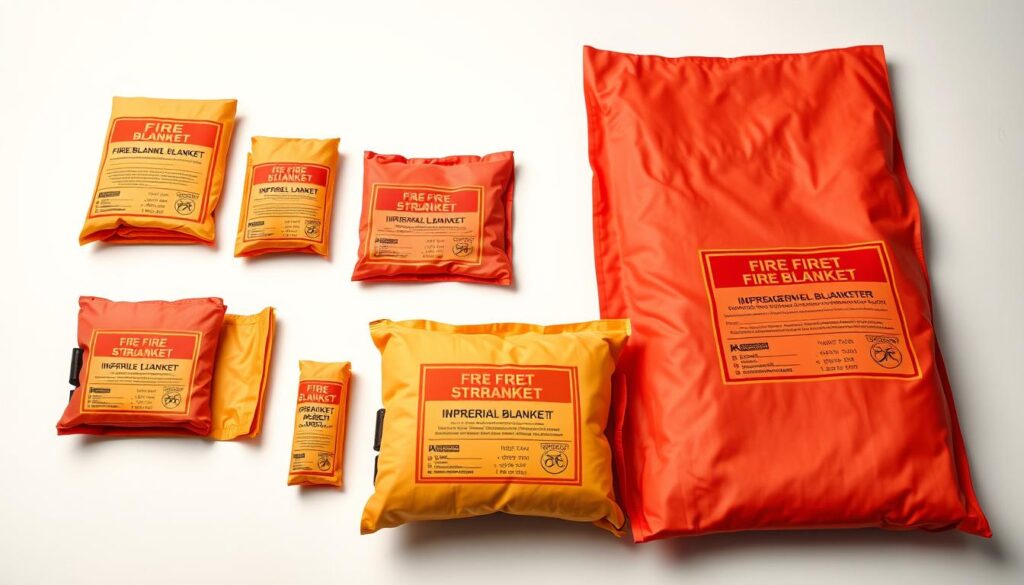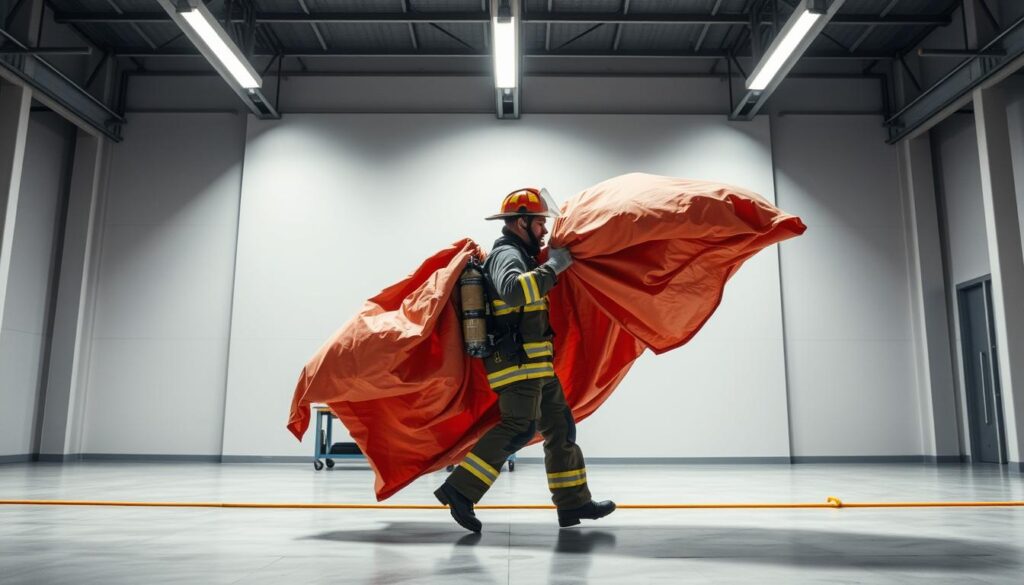Are you confident that your home or workplace is equipped with the right fire blanket to handle small fires?
Fire blankets are a crucial component of fire safety, designed to extinguish small fires in and around the kitchen and home. With various sizes available, selecting the correct one can be daunting.
In the UK, BS EN1869 fire blankets come in three standard sizes: 1.1m x 1.1m, 1.2m x 1.2m, and 1.8m x 1.2m. Understanding the appropriate size for your specific needs is vital for effective fire safety.
Key Takeaways
- Understand the different standard sizes of fire blankets available in the UK market.
- Learn how to select the appropriate fire blanket size for your specific needs.
- Discover the importance of considering potential fire hazards when selecting a fire blanket.
- Find out about essential factors beyond size, including material quality and safety certifications.
- Gain practical advice for both residential and commercial applications.
Understanding Fire Blankets and Their Importance
Understanding the role of fire blankets is essential for effective fire safety measures. You need to know how they work and why they are a crucial part of your safety equipment.
What is a Fire Blanket?
A fire blanket is a specially designed sheet made from fire-resistant materials like silicone-coated glass fibre. It is used to smother small fires by cutting off the oxygen supply, which is essential for flames to burn. Unlike fire extinguishers, fire blankets are simple to use and require no specialised training.
Why Every Home and Workplace Needs a Fire Blanket
Every home and workplace benefits from having fire blankets as part of their safety equipment. They are particularly effective for containing small fires in kitchens, where water or conventional extinguishers might worsen the situation, especially with oil or grease fires.
| Benefits of Fire Blankets | Description |
|---|---|
| Effective for Class F Fires | Ideal for cooking oils and fats, making them a must-have in kitchens. |
| Simple to Use | No specialised training is required, making them accessible to everyone. |
| Prevents Escalation | Can prevent small incidents from becoming dangerous situations. |
By incorporating fire blankets into your fire safety plan, you can ensure a multi-layered approach to fire protection that addresses different types of fire hazards effectively.
How to Choose the Correct Fire-Blanket Size
The size of your fire blanket can significantly impact its effectiveness in putting out fires, making it vital to choose the right one. When it comes to fire safety, having the correct equipment is crucial, and the size of your fire blanket is no exception.
Standard Fire Blanket Sizes Available in the UK
In the UK, fire blankets are available in three standard sizes according to the BS EN1869 standard: 1.1m x 1.1m, 1.2m x 1.2m, and 1.8m x 1.2m. These sizes cater to different applications and fire hazard levels, ensuring that you can find the right fire blanket for your needs.
| Size | Application |
|---|---|
| 1.1m x 1.1m | Ideal for domestic kitchens and minor incidents |
| 1.2m x 1.2m | Suitable for larger kitchen appliances and small workshop fires |
| 1.8m x 1.2m | Recommended for commercial kitchens, laboratories, and industrial settings |
Matching Fire Blanket Size to Potential Fire Hazards
To choose the correct fire-blanket size, you need to assess the potential fire risks in your environment. Consider factors such as cooking equipment, flammable materials present, and room dimensions. For instance, a smaller fire blanket (1.1m x 1.1m) is typically suitable for minor kitchen incidents, while larger sizes are needed for more significant fire hazards.

When matching fire blanket size to potential hazards, consider not just the initial fire source but also nearby flammable materials that could become involved. Ensuring your blanket can adequately cover the entire affected area is crucial. For environments with multiple types of fire risks, having different sized fire blankets strategically placed near specific hazard points provides optimal protection and response capability.
Key Factors to Consider When Selecting Fire Blankets
When it comes to fire safety, selecting the right fire blanket is crucial for effective emergency response. You need to consider several factors to ensure that your fire blanket is suitable for the potential fire hazards in your home or workplace.
Material Quality and Durability
The material quality of a fire blanket is paramount. Premium fire blankets are made from silicone-coated glass fibre, which provides superior heat resistance and durability during emergency situations. You should prioritize fire blankets that are made from high-quality materials to ensure they can withstand extreme temperatures and last longer.
Certifications and Safety Standards (BS EN1869:2019)
Always verify that your fire blanket meets the current BS EN1869:2019 certification, which ensures the product has undergone rigorous testing for effectiveness in smothering fires and protecting users. This certification is a guarantee that the fire blanket has been manufactured to high safety standards.
Ease of Access and Deployment Features
The ease of deployment is critical during fire emergencies. You should prioritize fire blankets with clearly marked pull tabs, sturdy handles, or straps that facilitate quick and intuitive use when seconds count. Consider the storage and mounting options available, as wall-mounted fire blankets in rigid or soft cases provide optimal visibility and accessibility. Fire blankets should be positioned strategically in areas where fires are most likely to occur, but not so close to potential fire sources that they become inaccessible.

Additionally, fire blankets should feature simple deployment mechanisms that anyone can use effectively, making them particularly valuable in homes and public spaces. The presence of clear, pictorial instructions on the fire blanket container significantly enhances usability during high-stress emergency situations.
Proper Placement and Maintenance of Fire Blankets
The effectiveness of a fire blanket depends on its placement and maintenance. You need to ensure that your fire blanket is easily accessible and properly maintained to effectively respond to fires, particularly in high-risk areas like the kitchen.
Optimal Locations for Fire Blanket Installation
Optimal placement of fire blankets is crucial for emergency response effectiveness, with kitchens being the primary location due to the higher risk of cooking-related fires. You should mount fire blankets on walls at eye level, clearly visible and accessible, with appropriate fire safety signage. Never install fire blankets directly above or adjacent to cooking appliances or heating elements. In commercial kitchens, place multiple fire blankets at strategic locations.
Inspection and Replacement Guidelines
You should conduct regular inspections of your fire blanket every six months, checking for damage, ensuring the container opens properly, and verifying that the blanket unfolds as designed. If you use your fire blanket, replace it immediately, regardless of its apparent condition, as its fire-resistant properties may be compromised. Maintain clear access paths to all fire blanket locations, ensuring they aren’t obstructed by furniture or equipment.
Conclusion
In conclusion, selecting the right fire blanket is a vital step in ensuring your safety and the safety of those around you. To effectively manage fire risks, consider the size, material, and placement of your fire blanket. Standard UK fire blankets come in various sizes to suit different environments and hazards. Ensure your chosen blanket meets the BS EN1869:2019 certification standards and is easily accessible in case of an emergency. By doing so, you’ll enhance your fire safety measures and be better equipped to handle potential fires.



